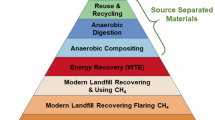Abstract
Recent efforts to generate renewable energy on a local scale and distributed basis have resulted in renewed interest in converting municipal solid waste (MSW) to energy. In addition, U.S. MSW generation has increased from about 1.1 tons per capita in 1990 to 1.3 tons in 2002, and worldwide, MSW generation is projected to double by 2030. Furthermore, many countries have established very strict limits on materials suitable for landfilling such as completely banning organic material from entering landfills. Typical MSW contains approximately 2800 kWh of heating content and is capable of yielding nearly 700 kWh of electricity in modern waste to energy (WTE) facilities. The composition of MSW has been demonstrated to be about 66% biogenic, thus today’s modern WTE facilities avoid 30 million tons per year of CO2 equivalent by avoiding CO2 from fossil fuel power plants and methane from landfills. Finally, research data shows that regions employing WTE facilities have a higher recycling rate. Therefore, increasing the usage of WTE facilities worldwide has the potential to satisfy a large part of the global energy demand while reducing greenhouse gas emissions and providing a safe waste disposal option. This paper will describe the current situation worldwide with some focus on the U.S. Some description and discussion on the dominant technology, mass burn, as well as other next generation technologies will be included. While all WTE emissions are well below regulations, particular emphasis will be placed on emission reduction schemes and potential for future advancement such as optimal pre-shredding, oxygen enhancement and conversion of MSW to fuels.















Similar content being viewed by others
References
U.S. Environmental Protection Agency: Municipal Solid Waste in the United States: 2001 Facts and Figures. U.S. EPA530-R-03-11, Washington, D.C. (2003)
Horinko, M., Holmstead, J.: Letter to the Integrated Waste Services Association (IWSA). U.S. EPA, Washington, D.C. http://www.wte.org/epaletter.html (2003). Accessed 14 Feb 2009
Themelis, N.J.: Global growth of traditional and novel thermal treatment technologies. Waste Manage. World. Review Issue, International Waste Management and Landfill Symposium, pp. 2000–2030, Cagliari, Italy, 1–5 Oct 2007
Themelis, N.J., Ulloa, P.A.: Methane generation in landfills. J. Renew. Energy 32(7), 1243–1257 (2007)
Themelis, N.J., Ulloa, P.A.: Capture and utilization of landfill gas. Renew. Energy, 77–81 (2005)
Niessen, W.R.: Systems Study of Air Pollution from Municipal Incineration. NAPCA, U.S. DHWE, Contract CPA-22-69-23 (1970)
Stevens, R.H.: Incinerator Overfire Mixing Study—Demonstration of Overfire Jet Mixing. OAP, U.S. EPA Contract 68020204 (1974)
Kopa, R.D., Kimura, H.: Exhaust gas recirculation as a method of nitrogen oxides control in an internal combustion engine. In: Proceedings of the APCA 53rd Annual Meeting, Cincinnati, OH (1960)
Detroit Diesel Corporation: The ABC’s of Exhaust Gas Recirculation (EGR). Detroit Diesel Corporation, Detroit, MI. http://www.detroitdiesel.com/public/brochures/6SA591.pdf (2003). Accessed 12 Aug 2009
Psomopoulos, C.S., Bourka, A., Themelis, N.J.: Waste-to-energy: a review of the status and benefits in USA. Waste Manage. 29, 1718–1724 (2009)
Kaufman, S., Krishnan, N., Kwon, E., Castaldi, M., Themelis, N., Rechberger, H.: Examination of the fate of carbon in waste management systems through statistical entropy and life cycle analysis. Environ. Sci. Technol. 42(22), 8558–8563 (2008)
Koralewska, R.: SYNCOM-Plus—an optimized residue treatment process. In: Proceedings of the 17th North American Waste-To-Energy Conference, pp. 1–4. ASME International, Chantilly, VA, paper #2375 (2008)
Krichten, D.J., Baxter, W.J., Baukal, C.E.: Oxygen enhancement of burners for improved productivity. In: Proceedings of the 1997 TMS Annual Meeting, pp. 665–672. TMS Extraction and Processing Division, Orlando, FL (1997)
Hoke, B.C., Inskip, J.L.: A comparison of oxygen-enhanced combustion technologies. Ceram. Eng. Sci. Proc. 23(1), 135–151 (2002)
Werther, J., Ogada, T.: Sewage sludge combustion. Prog. Energy Combust. Sci. 25, 55–116 (1999)
Beaumont, E.L.: The eco/Tech sludge recycling system: new waste streams, new revenues. In: Proceedings of the 10th North American Waste-To-Energy Conference, pp. 87–88. ASME International, Philadelphia, PA (2002)
U.S. Department of Energy Information Administration, U.S. Electricity Supply Data. http://www.usdoe.gov (2008). Accessed 1 June 2008
Themelis, N.J., Kaufman, S.M.: Waste Management World. ISWA. www.iswa.org. Sept–Oct 2004 Issue
Michaels, T.: Waste Not, Want Not: The Facts Behind Waste to Energy. Integrated Waste Services Association (IWSA). http://www.wte.org/waste-want-a2971 (2008). Accessed 5 June 2009
America’s Own Energy Source, Published by the American Society of Mechanical Engineers, The U.S. Conference of Mayors, The Solid Waste Association of North America, and the Integrated Waste Services Association, December (2006)
Belgiorno, V., Feo, G.D., Rocca, C.D., Napoli, R.M.A.: Energy from gasification of solid wastes. Waste Manage. 23, 1–15 (2003)
Bridgwater, A.V.: The technical and economic feasibility of biomass gasification for power generation. Fuel 74(5), 631 (1995)
Bridgwater, A.V.: Renewable fuels and chemicals by thermal processing of biomass. Chem. Eng. J. 91, 87 (2003)
Cunliffe, A.M., Williams, P.T.: Influence of process conditions on the rate of activation of chars derived from pyrolysis of waste tyres. Energy Fuels 13, 166 (1999)
Caputo, A.C., Pelagagge, P.M.: RDF production plants: I. Design and costs. Appl. Therm. Eng. 22, 423–437 (2002)
Rezaiyan, J., Cheremisinoff, N.P.: Gasfication Technologies: A Primer for Engineers and Scientists. Taylor and Francis, Boca Raton (2005)
Prins, M.J., Ptasinski, K.J., Janssen, F.J.J.G.: Thermodynamics of gas-char reactions: first and second law analysis. Chem. Eng. Sci. 58, 1003–1011 (2003)
Miyoshi, F., Yamada, S.: Gasification method for solid waste gasification and melting—current state of Thermoselect operations. In Japanese, translation by M. Nakamura. Kankyo joka gijutsu [Environ. Solut. Technol.] 5(11) (2006)
Author information
Authors and Affiliations
Corresponding author
Rights and permissions
About this article
Cite this article
Castaldi, M.J., Themelis, N.J. The Case for Increasing the Global Capacity for Waste to Energy (WTE). Waste Biomass Valor 1, 91–105 (2010). https://doi.org/10.1007/s12649-010-9010-1
Received:
Accepted:
Published:
Issue Date:
DOI: https://doi.org/10.1007/s12649-010-9010-1




